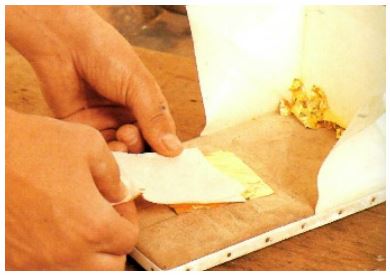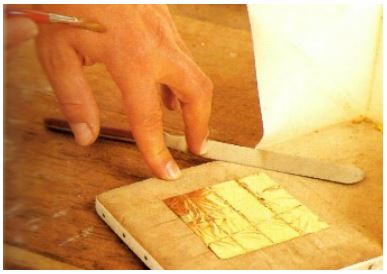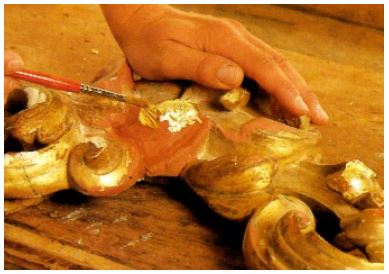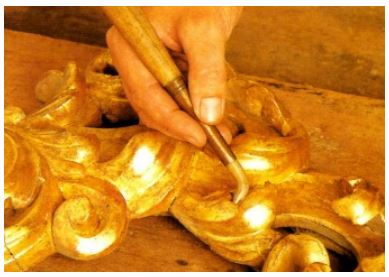
Introduction
Gilding is a method of enhancing and disguising wood to give a better appearance. It was performed either as water gilding or oil gilding, both requiring a high level of skill to undertake successfully. It was quite popular in the 17th and 18th centuries, particularly in Europe and Asia.
The most common forms of gilt were to decorate and highlight furniture. Both oil gilt and water based gilt can deliver highly decorative result and each is highly distinctive. The application of gilt does require a combination of specialist skills, specialist tools and a great degree of patience and experience. Of the two types of gilt, water gilt tended to be the most common.
To apply a gilt finish, it needs to be done on a foundation of gesso coated in bole. Gesso is a mixture of powdered chalk, rabbit-skin glue and boiled linseed oil. It is traditionally mixed in a gesso kettle over heat. It was typical for a number of coats of gesso to be applied to the surface to build a suitable profile. If a textured surface was required, fine sand was also added to the mixture. Over the top of the gesso, a coat of bole is applied. Bole is a mixture of clay and water and can be either red, white or blue in colour. A size of alcohol, rabbit-skin glue and water is then applied. When dry, this is the foundation to which the gold leaf is applied.
The gold used in gilding is produced by repeated machine rolling then hand beaten into leaves of varying fineness. The grade of gilt will depend on the number of carats of the gold leaf. The gold leaf is applied using an agate, which pulls the sheets of leaf together.
Water Gilding - Stages

Gilt Toolkit
The tools of the gilder have remained fairly constant for over 200 years. In their original form, the agate burnishes were made from dog’s teeth. These have now been replaced by modern plastics.
The agate burnishes come in a range of shapes and sizes and are designed to bring a mirror like polish to the gilt and ensure that all gaps in the gilt are closed and sealed.
Then other key tools in the gilders toolkit includes:
● The suede pad as a work surface for handling the gold leaf.
● A flat blunt knife for cutting gold leaf.
● A gilders fitch which is like an artists brush. The brush is rubbed against the skin to create a static electrical charge to help handle the delicate gold leaf.
● A gilders mop which is a large mop-like brush used to remove excess gilt from the work space.

The Gilding Process
The gilding process is one that requires attention to fine detail, patience and strict adhering to the the steps in the gilding process. High quality outcomes are unlikely to be achieve otherwise. High quality gold leaf can be expensive, so waste is not a option. As a general rule, the following steps will apply.

1. Mix gesso ingredients and apply them to the wood surface. When dry, the gesso can be shaped to the desired profile.

2. Lightly sand the gesso using a fine grade sand paper. The extent of the finish w ill be guided by the desired texture of the finish.

3. Apply a coat of bole onto the gesso. Red bole is being used here to match the original restoration colours. The bole is applied w arm w ith a soft brush. Then sanded.

4. Place a sheet of gold leaf on a suede pad and peel off the backing. Care is needed in handling gold leaf as even the slightest draught w ill blow it around.

5. Because the leaf is so light and difficult to handle, one of the best techniques is to use static electricity. Simply rub the gilders fitch against your skin to build up a little static electricity on the brush. This enables the very fine leaf to be manipulated.
The second stage of the process is the application and finishing of the gold leaf to the surface. On highly carved surfaces, great care is needed to ensure that appropriate coverage occurs, particularly in grooves and sharp edges.

6. With fitch charged, simply touch the bristles to the gold leaf to lift it f rom the pad and place it on the work surface

7. Lay the leaf dow n on the sized area. The size w ill pull it dow n into the various contours. Repeat the process until all of the bole has been covered. Rushing this step w ill affect the final finish.

8. Dust over the surface with the mop. This w ill remove any loose or excess gilt, exposing any areas yet to be covered. Gilt scraps can be applied to exposed areas.

9. Use an agate to burnish the surface creating an even surface and toning it.

10. A close up of the finished article after the completion of the gilding process and restoration.
Glossary of Terms
Agate: a tool traditionally made from dog’s teeth used to finish and burnish gilt.
Bole: A clay like substance that is used in the gilding process.
Fitch: A soft brush like an artists brush used to manipulate gold leaf.
Gesso: A plaster like substance that is used in the gilding process. Ingredients include - powdered chalk, rabbit-skin glue, and boiled linseed oil.
Gesso Kettle: A pot used to mix gesso ingredients.
Gold leaf: The finish applied in the gilding process.
Mop: A soft mop-like brush used to remove loose gilt from the work surface.
Size: A coating of alcohol and rabbit-skin glue placed on the surface to allow the gold leave to adhere to the surface.

Article submitted by Don Jones, Carbatec Customer Care Team.
As a restorer and preserver of beautiful furniture, Don often sees the results of years of neglect or misplaced good intentions on caring for wooden furniture of all ages. Whether you are caring for a 100 year old antique, a new purchase or something you have created yourself, Don shares some insight into caring for your furniture.
Click here to download a copy of Don's Gilt- Traditional Finishes Series
|